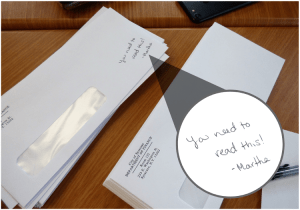Explainer: What is a behavioral ‘nudge’?

Suddenly, it seems, everyone in the public sector is “nudging.”
The strategy is credited with boosting back-tax payments, attracting police recruits, reducing unnecessary antibiotic prescriptions, and increasing the number of organ donors. More than a dozen countries have set up offices that some call “nudge units” to lead experiments using behavioral science. Meanwhile, a growing number of U.S. cities have gained experience with nudging through What Works Cities, a Bloomberg Philanthropies initiative that has helped 100 cities boost their use of data and evidence to improve outcomes for residents.
Indeed, nudging is a critical innovation tool for cities today. But what is it? Here, in our latest explainer, Bloomberg Cities cuts through the jargon to help you understand this important concept and what it means for city leaders.
What’s a nudge?
A nudge is one aspect of how behavioral science can be applied in the public sector. It comes into play specifically around choices people have to make: Should I see the doctor? Should I pay this parking ticket? Should I save for retirement? A nudge changes the presentation of those choices in a way that makes people more likely to pick the option that benefits them.
Consider the choice of whether to join an employer’s pension plan. It matters a lot whether that choice is to “opt in” to join the plan — or “opt out” to not join. In the U.K., a 2012 rule change meant that workers were enrolled by default but also free to leave. Pension enrollments skyrocketed.
One critical point: While nudging may reframe choices, it doesn’t restrict them. In the pensions example, workers can still say no. Nudging is not a mandate. It’s also different from other, arguably more forceful economic tools governments can use to influence behavior like taxes or other economic incentives.
Nudging is informed by a growing body of research in the field of behavioral economics. The pensions policy, for example, draws on deep evidence showing that inertia is a powerful force — one that can be easily channeled to favor the public interest simply by changing how the choice is offered. What’s more, these changes can be easily tested, using randomized-control trials, to confirm whether or not they work in practice.
[Read: Behavioral science is quietly revolutionizing city governments]
As the use of behavioral insights grows in government, the word “nudge” is taking on a somewhat broader meaning. “The term is used nowadays to mean anything that involves psychology in government,” said Michael Hallsworth, who leads the North American division of the Behavioral Insights Team, a social purpose company that spun off from the British government’s work in this area in 2014.
“But strictly speaking,” Hallsworth said, “nudge is about changing the presentation of choices for people so they’re more likely to choose one option rather than the other.”
Where did nudging come from?
The idea was popularized 10 years ago in the best-selling book, “Nudge,” by Richard Thaler and Cass Sunstein. Although nudging wasn’t new to the field of marketing, it was a novel strategy for the public sector.
The authors positioned nudging as something that could appeal to leaders across the political spectrum. They called it a form of “libertarian paternalism.” Nudging gives government a new tool to “steer people’s choices in directions that will improve their lives,” they wrote, while also striving “to design policies that maintain or increase freedom of choice.”
Sunstein went on to work on reforming regulations in the Obama White House, and later founded the Program on Behavioral Economics and Public Policy at Harvard Law School. Thaler won the Nobel Prize in economics in 2017 for his work in the field.
[Read: Making revenue collections more effective: lessons from a Nobel laureate]
Meanwhile, nudging caught on. It arrived at just the right time, when a global financial crisis had governments everywhere interested in low-cost approaches that save money and deliver results.
What’s the appeal of nudging?
Foremost, nudging is inexpensive. Often, it merely involves tweaking something government is doing already, like sending collection letters to people who owe fines, or reminders about appointments. “We’re sending the message anyway,” Hallsworth said. “So why not send a message that will be more effective, and get better results for the same cost?”
Not every nudge works. And when it does, the results may be incremental. But increasing tax-payment rates by just a percentage point adds up to real money fast. In addition, results can often be achieved quickly. While nudging typically involves running rigorous randomized-control trials to determine what works, the lift is designed to be lighter and faster than with a typical academic study.
All in all, nudging is a pragmatic way to inject evidence into public-sector decision making, moving away from approaches based largely on intuition or “the way things have always been done,” and toward approaches that are proven to work. Cities are fertile ground for nudging because local governments have so much direct contact with residents, and there’s often fewer bureaucratic hurdles to overcome in cities than at other levels of government.
What are some city-level examples of nudges in action?
Most local-government examples of nudging so far have to do with letters, text messages, and other forms of communication with residents. For example, Syracuse, N.Y., nudged people who were behind on their property-tax payments by sending them letters with a handwritten note on the envelope. The experiment netted the city an additional $1.5 million in payments.
[Read: How a handwritten not helped Syracuse collect $1.5 million in back taxes]
Similarly, Chattanooga, Tenn., and Lexington, Ky., found success with redesigning letters sent to people with unpaid sewer bills. The letters clarified how to pay and noted that a consequence of not paying could be having one’s water service disconnected. Chattanooga and San José, Calif., have used nudge tactics to attract more diverse recruits for their police forces, while New Orleans has nudged residents to visit the doctor by sending them text messages.
Durham, N.C., a winner in the 2018 Bloomberg Philanthropies Mayors Challenge, is testing whether nudges can get commuters out of their cars and into alternatives such as carpooling, cycling, walking, or riding transit. The city has had some success with offering commuters help with planning alternative routes to work and automatically emailing people personalized route maps. Another idea that worked was to enter bus riders into a weekly lottery for a chance to win a $163 cash prize.
“There’s a reason gambling is so prolific,” said Joseph Sherlock, a senior behavioral researcher with the Duke University Center for Advanced Hindsight. “Here’s a way to take that insight and apply it to something more prosocial: Getting someone to ride the bus.”
Is nudging enough?
Compared with traditional levers of public policy, such as taxing or regulation, nudging can seem like small stuff. But experts in the field say behavioral insights can be applied more broadly to policy making. “A tax is not a nudge,” Hallsworth said, “but you can use these ideas from behavioral science to structure a tax more effectively.”
Erin Sherman agrees. The vice president of Ideas42, a nonprofit behavioral design firm that works with a lot of public-sector organizations, worries that nudging is coming to be seen as a batch of one-time fixes — letters or reminder notices layered on top of entrenched programs. “That connotation of nudge — that it’s something you put on top at the end like icing on a cake, misses an opportunity,” Sherman said. “It’s the opportunity to ask a really good question about behavior, and to design for that from the get-go.”
Is nudging manipulative?
Since it started, nudging has had detractors who argue the practice amounts to government coercion, or that running behavioral trials is akin to doing experiments on people. The critique seems to fade as nudging becomes more commonplace. Research also has shown evidence of a “partisan nudge bias” — essentially, people tend to support nudging when it supports a policy goal they agree with.
Duke University’s Sherlock offers a counter-argument: that government has a responsibility to nudge. He points to all the lousy government forms that are already in the world and shaping people’s choices.
[Read: 7 behavioral insights tips from pioneering cities in the field]
“Often, there’s a default — you’ve already got a tax form, for example. So you can either design it in an uninformed way, or take responsibility for doing it in an evidence-based and user-centered way,” he said. “Governments have a responsibility to do as well as we can with the decision context. Not thinking about it is irresponsible and poor governance.” Sherlock says the key to overcoming resistance to nudging is to be transparent about it.
Katherine Milkman, a behavioral economics expert at the University of Pennsylvania’s Wharton School of Business, agrees. “Those of us doing the work have a responsibility to be good stewards of the public trust and transparent about what we’re doing,” she said. “As long as we’re nudging people toward their own best intentions, we’ll see less and less critiques.”
What’s the future of nudging?
Nudging is still relatively new, and has a lot of room to grow.
Milkman said what you might call “Nudge 1.0” was mostly about using behavioral insights to influence single decision points: Getting people to become an organ donor, or show up for their flu shot. “Nudge 2.0 will be about changing decisions in a more lasting way,” she said. “Not just single decisions but daily decisions like exercise, eating, saving, and spending. It’s harder to change someone in a more enduring way than to just change or shape a single decision when you have their attention. But it’s an important goal given how many of our decisions are small and repeated, and end up having big consequences.”
Sherman of Ideas42 thinks cities have a lot of work to do in helping people sign up for services to which they are entitled. “There’s no excuse for how difficult it is to sign up for services,” he said. Nudging could help. She also sees a lot of potential in nudges that would help the fight against climate change, whether it’s encouraging people to drive less or conserve more energy at home. Ideas42 will be working with a number of U.S. cities who won the Bloomberg Philanthropies American Cities Climate Challenge to do just that. “There’s so much good research on how to change how people use energy,” Sherman said. “It’s time to scale it up.”
Government leaders might also think about a new audience of people to nudge: themselves. Hallsworth said policymakers, too, are susceptible to biases that can impact decision making. Last year, the Behavioral Insights Team released a report that aimed to start a discussion about how to draw on behavioral science to improve the way governments make policy.
“We tend to think about nudging the population and changing policies to do that, but what about the biases in the systems of government itself?” Hallsworth said. “We’ve done some initial thinking on it, and it would be great to turn it into practice.”
Read more explainers from Bloomberg Cities:



